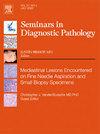冰冻切片分析在头颈部及内分泌病理中的重要性
IF 3.5
3区 医学
Q2 MEDICAL LABORATORY TECHNOLOGY
引用次数: 0
摘要
头颈部和内分泌(HNE)恶性肿瘤的诊断涉及组织学特征与临床和放射学表现的相关性,理想情况下,采用多学科方法。冰冻切片检查从口腔、鼻窦区、咽、喉、唾液腺或甲状腺的HNE病变,为术中组织诊断、标本边缘评估、肿瘤浸润深度和确定其他重要的组织学特征提供了即时的评估。唾液腺肿瘤的冰冻切片有助于区分良性和恶性、低级别和高级别肿瘤,并评估淋巴结累及情况。诊断方式的进步,包括世卫组织第5版的更新,提高了病理学家应对这些具有挑战性的诊断的能力。这篇综述强调了在日常HNE实践中经常遇到的冷冻切片要求,并讨论了诊断挑战和鉴别诊断。本文章由计算机程序翻译,如有差异,请以英文原文为准。
The importance of frozen section analysis in head, neck, and endocrine pathology
The diagnosis of head, neck, and endocrine (HNE) malignancies involves the correlation of histologic features with clinical and radiological findings and, ideally, in a multidisciplinary approach. Frozen section examination of HNE lesions from the oral cavity, sinonasal area, pharynx and larynx, salivary gland, or thyroid gland provides an immediate intraoperative evaluation for a tissue diagnosis, specimen margin assessment, tumor depth of invasion, and determining other important histologic features. Frozen sections of the salivary gland tumors help to differentiate benign from malignant and low-grade from high-grade tumors and evaluate lymph node involvement. Advances in diagnostic modalities, including updates in the WHO 5th edition, have enhanced pathologists' ability to navigate these challenging diagnoses. This review highlights the frequently encountered frozen section requests in daily HNE practice and discusses diagnostic challenges and differential diagnosis.
求助全文
通过发布文献求助,成功后即可免费获取论文全文。
去求助
来源期刊
CiteScore
4.80
自引率
0.00%
发文量
69
审稿时长
71 days
期刊介绍:
Each issue of Seminars in Diagnostic Pathology offers current, authoritative reviews of topics in diagnostic anatomic pathology. The Seminars is of interest to pathologists, clinical investigators and physicians in practice.

 求助内容:
求助内容: 应助结果提醒方式:
应助结果提醒方式:


